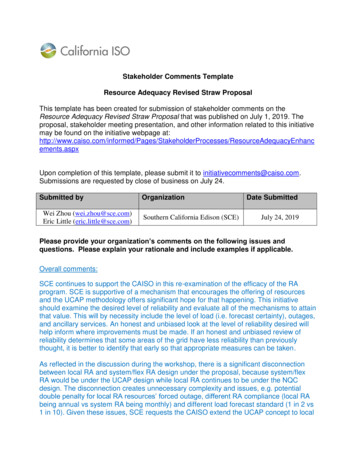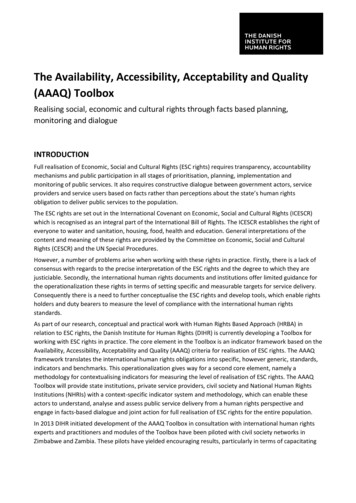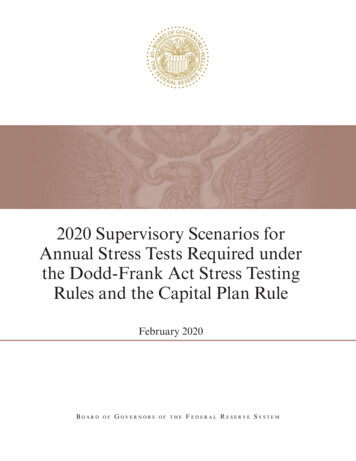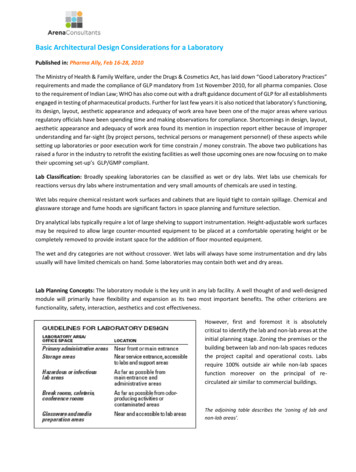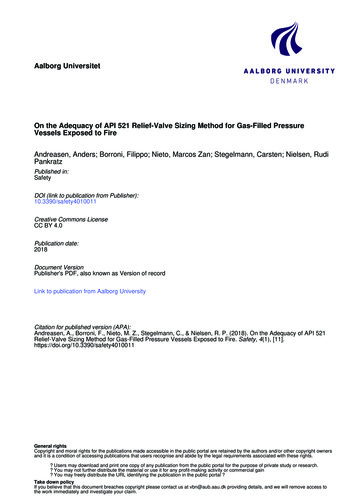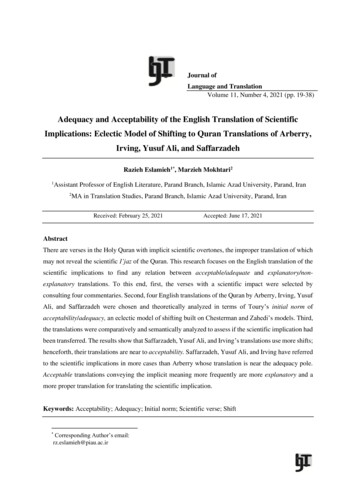
Transcription
Journal ofLanguage and TranslationVolume 11, Number 4, 2021 (pp. 19-38)Adequacy and Acceptability of the English Translation of ScientificImplications: Eclectic Model of Shifting to Quran Translations of Arberry,Irving, Yusuf Ali, and SaffarzadehRazieh Eslamieh1*, Marzieh Mokhtari21Assistant Professor of English Literature, Parand Branch, Islamic Azad University, Parand, Iran2MA in Translation Studies, Parand Branch, Islamic Azad University, Parand, IranReceived: February 25, 2021Accepted: June 17, 2021AbstractThere are verses in the Holy Quran with implicit scientific overtones, the improper translation of whichmay not reveal the scientific I’jaz of the Quran. This research focuses on the English translation of thescientific implications to find any relation between acceptable/adequate and explanatory/nonexplanatory translations. To this end, first, the verses with a scientific impact were selected byconsulting four commentaries. Second, four English translations of the Quran by Arberry, Irving, YusufAli, and Saffarzadeh were chosen and theoretically analyzed in terms of Toury’s initial norm ofacceptability/adequacy, an eclectic model of shifting built on Chesterman and Zahedi’s models. Third,the translations were comparatively and semantically analyzed to assess if the scientific implication hadbeen transferred. The results show that Saffarzadeh, Yusuf Ali, and Irving’s translations use more shifts;henceforth, their translations are near to acceptability. Saffarzadeh, Yusuf Ali, and Irving have referredto the scientific implications in more cases than Arberry whose translation is near the adequacy pole.Acceptable translations conveying the implicit meaning more frequently are more explanatory and amore proper translation for translating the scientific implication.Keywords: Acceptability; Adequacy; Initial norm; Scientific verse; ShiftCorresponding Author’s email:rz.eslamieh@piau.ac.ir*
Adequacy and Acceptability of the English Translation of 20INTRODUCTIONstudies have mainly considered the scientificI’jaz at semantic or linguistic level. For example,Some verses in the Quran have surfaceAghayani Chavoshi (2012) studied the medicalmeanings, easily understood, but have implicitaspects of some verses. Ebrahimi and Fazilmeanings that may raise translators’ problems.(2012) extracted the references to the growthVerses with scientific1 overtones mainly causeand development of the human fetus in somecomplications for translators as the scientificBook verses. In Scientific Truths in the Qur’ānpurpose demands Exegesis. On the other hand,(2019), there are chapters on many differentthe development of science and technologyscientific points of the Scripture, including thebrings about discoveries about the scientificBig Bang Theory, the development of thehints of some verses. Moreover, the translationuniverse, the uniqueness of fingertips, the lobesshould necessarily reveal the scientific point.of the human brain and many other scientificHowever, above all, the scientific aspect of thesepoints.verses is not transferred by word for wordIn the field of translation, there are somerendering and the solution for the problem is toresearch near to the topic of the present research.provide more explanation. Providing more proofShahinpoor (2011) studied the Farsi translationsis a kind of shift. Hence, the notion of shift has aof the scientific verses. Mohammed Farghal andvital key in this study. By studying the frequencyNoura Bloushi (2012) studied Blum-Kulka’sand types of shifts in translation, kind of thereader-focused and text-focused coherencegoverning norm is established. The purpose ofshifts in five English translations of the Quran.this study is to assess which of the four selectedHeidarinia (2014) worked on the shifts in theEnglish translations of the Quran is near totranslation of some Quran similes in ten Englishadequacy and which one is near to acceptability.translations of the Book. Hussein Abdul RaofThese two directions for the translated text are(2005) studied the culture-specific shifts inToury’s initial norm of translation. The studytranslating Quran to English and classified themalso means to find if there is any relationbased on Catford’s shift types. Yahya Dkhissibetween(2018) studied selected grammatical functionsacceptability/adequacyandexplanatory/ non-explanatory translations.that cause syntactic asymmetries in the EnglishThere are an adequate number of studies thattranslations of the Quran. “Mode in Arabic-reveal the Scientific I’jaz of the Quran. But suchEnglish Translation: concerning the Quran”Oxford Dictionary defines ‘scientific’ as“Relating to or used in science”. Merriam Websterdefines the term as “of, relating to, or exhibiting themethods or principles of science”. a similar definition“relating to science,orusingthe organized methods of science”. Henceforth, inthis study, any verse related to any field of science isconsidered scientific. It is crucial to note that thoughthere are diverse sciences, the main focus of thisstudy is biological, medical science, agriculturalscience and other related sciences with the exclusionof mathematical science, computer science,engineering and technological sciences. As the latterfields are scarcely, if not, referred to in the HolyQuran.1
21Journal of Language and Translaion, Volume 11, Number 4, 2021(2019) studied the translation of rhetoricalin translation studies by Jiëí Levý (1963). Itquestions of the Quran in two Englishreappeared in Itamar Even-Zohar’s doctoraltranslations based on the register theory ofdissertation (1971) and was built upon in theHalliday and Hassan (1985) and the shiftingworks of Toury (1977, 1980, 1995).Norms are “do’s and dont’s” that apply tomodel of Catford (1965).Despite the richness of works on the Englishvarious behavioural patterns in society. Normstranslation of the holy verses, few studies haveare defined “as the translation of general valuesassessedimplications.or ideas shared by a community – as to what isFurthermore, almost no research has studied theright and wrong, adequate and inadequate – intoadequacy and acceptability of the Englishperformance instructions appropriate for andtranslation of the scientific overtones. Theapplicable to particular situations” (G. J. D. t. s.present paper uses an eclectic model of shiftingToury & beyond, 1995, p. 55). As such normsbased on Andrew Chesterman’s pragmaticapplystrategies for translation (1997) and Zahedi’s(Weissbrod, 1998, p. 4). In the area of(2013). The frequency of shifts in eachtranslation, Toury (1995) distinguishes threetranslation is the criterion for classifying texts astypes of ooadequate or acceptable. Despite the abundanceInitial norms deal with the translator’sof works that consider shifting inappropriate foroverall approach; whether to follow the normsQuran translation, the purpose of this research isof the source text or the target text: “If ato find if shifting is appropriate for translatingtranslation is source-text oriented the TT will bescientific pproach will result in an acceptable translation”THEORETICAL FRAMEWORK(G. J. D. t. s. Toury & beyond, 1995, p. 56). Theinitial norms make up the orientation to theNormssource system (adequacy) or the target system(acceptability).The concept of norms, a key concept in Tel AvivSchool of poetics and semiotics, was first usedInitial normSubjection to source normsAdequate translationsubjection to target culture normsacceptable translationFigure 1. Toury’s initial norm and the continuum of adequate and acceptable translation (Munday,2016, p. 178)
Adequacy and Acceptability of the English Translation of 22formulation of the text, the relation between theIt is crucial to note that a continuum existsbetweenthetwoextremepoles.source text and the target text, and what willTouryvary and what will not significantly duringemphasizes that translation in practice is atranslation (G. Toury, 1995). Operational normsmatter of compromise between the two poles:have two subgroups: matricial norms govern“Actual translation decisions will necessarily“target-languageinvolve some ad hoc combination of, orsubstitutecompromise between the two extremes impliedlanguage material” (G. J. D. t. s. Toury &by the initial norm” (G. J. D. t. s. Toury &beyond, 1995, p. 59). These norms govern thebeyond, 1995, p. 57).distribution and segmentation of urce-Toury (1995) defines preliminary norms asmaterial in the translated text and the degree of“those regarding the existence and actual naturefullness of translation. Textual-linguistic normsof a definite translation policy, and those relatedgovern the selection of material that ultimatelyto the directness of translation” (p.58). Based onform the target text. Textual-linguistic norms arethis definition, preliminary norms involve twogeneral and apply to translations generally or arekey concepts. First, translation policy refers toparticularly applicable to “a particular text-typethe factors influencing the choice of a particularand/or a particular mode of translation only” (G.text- type (literary, legal, economic etc.) or aJ. D. t. s. Toury & beyond, 1995, p. 59). In thisparticular individual text (belonging to a specificstudy, Toury’s initial norms are used to classifyauthor, genre, movement, school, etc.). Here, atranslations as adequate or acceptable. Thehost of factors are involved: dominant powerclassification tests the hypothesis that “the morerelations, political conditions, cultural demandsexplanatory translations will be more successfulof the target culture and even the particularinneeds and obligations of publishing houses.Explanatory translations are reader-oriented.Second, directness of translation refers to theThis is like the notion of acceptability by Toury.tolerance of indirect translation: Is the ultimateFollowing the hypothesis, the non-explanatorytranslated text translated directly from thetranslations will be classified as adequatesource text, or is it a translation from sage”.Thus, the directness of translation refers to thetolerance for the mediated translation and theTranslational shiftsmediated language.Operational norms govern the decisionsTranslational shifts are one of the sources formade during the process of translation.studying translational norms. The translator is aOperational norms affect the distribution ofsocio-cultural agent whose ultimate approach tolinguistic material in a text (the matrix of a text),the target text will be determined by the shifts hethe textual make-up of the text, verbalimplements during translation. Technically
23Journal of Language and Translaion, Volume 11, Number 4, 2021speaking, shifts occur during translation or whileneed to be norm-governed to ensure that themoving from the source text to the target text.translation is not idiosyncratic.Shifts result from the systematic, structural,linguistic,metalinguisticandThe present research means to classify thestylistictranslations of the scientific verses of the Holydifferences or gaps (lacunae) between the sourceQuran based on Toury’s initial norm, whichlanguage and the target language.categorizes translations to two poles ofVinay and Darbelnet (1958; 1995; 2000)acceptability and adequacy with degrees andproposed a classical model of translationcompromise between the two extremes. Allprocedures for dealing with translation shifts.translators are obliged to practice obligatoryTheir model is significant as it formed the basisshifts; henceforth, studying compulsory shiftsfor later taxonomies of translation strategies andcannot affect the study’s final results. In thisprocedures. Catford introduced the term shiftregard, Viney and Darbelnet (1997) remark thatinto translation studies in 1965 in his linguisticnon-obligatory shifts should be the main priorityapproach to translation and defined it as “theof translators. In their theories on translationalchange of formal structure of the Sourcestrategies (shifts), they differentiate servitudelanguage into the Target language” (p.141).from option. By servitude, they mean obligatoryMalone (1988) used a highly idiosyncraticchanges in the translation because of theterminologyquitedifferent ST and TT systems. By option, theydemanding to use in practice (Chesterman,mean non-obligatory changes because of the1997). Van Leuven-Zwart’s model (1989; 1990)translator’s own decisions and preferencesstudied syntactic, semantic and stylistic shifts.(similar to Toury’s obligatory and non-She analyzed the effect of “micro level”obligatory shifts). Vinay & Darbelnet emphasizetranslation shifts on the “macro level”.that option or non-obligatory shift should be theofshiftingwhichisToury (1980; 1995) has also worked on themain priority of the translators:notion of shift and has acknowledged shift “as aFor the three-level on which wetrue universal of translation” (G. J. D. t. s. Touryshall carry out our analysis, the& beyond, 1995, p. 57). For Toury, translationlexicon, the syntactic structure, andshift is valuable because it is a form ofthe“discovery” or “a step towards the formulationbetween servitude and option isof explanatory hypotheses” about the act ofimportant. In the analysis of the SLtranslation (G. J. D. t. s. Toury & beyond, 1995,the translators must pay particularp. 85). Toury distinguishes two types of shifts:attention to the options. In the TLobligatory shifts, which he describes asthey must take account of thelinguistically motivated, and non-obligatoryservitudesshifts, which are due to literary or culturalfreedom of action and must be ableconsiderations. Toury relates shifts to norms.to choose from among the availableObligatory shifts as well as non-obligatory shiftsoptions to express the nuances ofmessage,thewhichdistinctionlimittheir
Adequacy and Acceptability of the English Translation of 24the message. (Vinay & Darbelnet,are more general and normally less conscious,1995, p. 16)answering questions like “how to translate thisBuilding on the role of options, they add thattext or kind of text”. Local strategies are moreoptions dominate the internal stylistics whereasspecific and conscious, solving problems suchexternal stylistics is under the influence of bothas “how to translate this structure/this idea/thisservitudes and options. Regarding the point, thisitem” (Chesterman, 1997, p. 90). Chesterman’sstudy focuses on non-obligatory shifts and theproposed strategies are linguistic and can all beclassificationnon-summarized in one single strategy: changeobligatory shifts is not the purpose, instead thesomething: “if you are not satisfied with thepurpose is to classify the translations with moretarget version that comes immediately to mind –number of shifts near to the pole of acceptabilitybecauseand the translations with less number of shiftssemantically odd, or pragmatically weak, ornear to the pole of adequacy. Toury does notwhatever – then change something in it”remark the type of shifts in his classification:(Chesterman, 1997, p. 92). These strategies fall“thetranslationinto three primary groups, which may overlap:involves shifts from the source text” (G. J. D. t.mainly syntactic/grammatical, mainly semantic,s. Toury & beyond, 1995, p. 57). Hence, to makeand mainly early an exhaustive study of shifts and toorthesure that almost all shifts are covered, the presentmanipulation of the message in a way that isstudy makes use of an eclectic model of shiftingmost comprehensible for the target audience.which includes Chesterman’s strategies ofPragmatictranslation shift and Zahedi’s model which isSchäffner and Wiesemann’s macro-strategiesalso an eclectic model.(2001), Nord’s choice for documentary andstrategiesarecomparabletoinstrumental translation (1997) and Toury’sChesterman’s strategies of translation shiftinitialnorms(1995). Chesterman (1997)proposes the following pragmatic strategies:In Memes of Translation (1997), Chestermandefines strategy and contends that translation1. Cultural filtering means adapting the ST tostrategies are also memes. Translators turn tocultural norms of the TL. This strategy isstrategiesproblems.particularly applicable to cultural-specific-itemsStrategies manifest textual manipulations thatof the ST. Strategies which make the TTare directly observable in the target textconformcompared to the source text. Chesterman’sexpectations are naturalization, domesticationstrategies are called transfer operations orand adaptation. Strategies which make the TTformal shifts by other scholars.resist target culture norms are exoticization,tosolvetranslationFor Chesterman (1997), there are two kindsof strategies, global and local. Global strategiestotargetcultureforegnization and estrangement.normsand
25Journal of Language and Translaion, Volume 11, Number 4, 20212. Explicitness change makes some implicittranslating just the sounds, transcription, gistinformation in the ST more explicit in the TTtranslation and etc.(explicitation) or some information is leftimplicit in the TT as the target reader may infer8. Visibility change means changing the statusthe information from the context translator’s visibility in the TT. The strategies3. Information change involves addition andwhich foreground the translator’s presence areomission. In addition, some information isfootnotes, translator’s comments, added glossesadded to the TT, which is not present in the STand other similar textual and paratextualand is not inferable but is relevant to the TT andmaterial.will help the readers. In omission someinformation, which is present in the ST, is9. Transediting which is suggested by Stettingomitted in the TT. The information is assumed(1989) happens when the original text is badlyto be irrelevant and is not inferable from the TT.written and the translator has to re-order, rewriteor re-edit it.4. Interpersonal change includes anything thatchanges the level of formality between the10. Adaptation or other pragmatic changesauthor and the reader. Changing the level ofinvolve any change at the level of text that mayformalityofmanipulate the original message according toaddressing, choice of lexical items, the overallthe target audience’s context. These changesstyle and the degree of emotiveness.include changing the layout, dialect and similarisreflectedthroughwaysattributes.5. Illocutionary change means changing ofspeech act; that is changing, for example, aThis study is limited to the pragmaticstatement to a request or changing the directstrategies of Chesterman (1997) mainly for twospeech to indirect speech.reasons. Firstly, some of Chsterman’s pragmaticstrategies are the same as Toury’s initial norm6. Coherence change involves changes at thewhich form the basis of this research. Secondly,arrangement of paragraphs or changes in thein most cases, the scientific aspect of verses canarrangement of sentences in a paragraph. Theneither be rendered by syntactic structure nor bytranslation strategy of relocation or dislocationsemantic significance, rather the meaning is inis categorized under cohesion change.the extra textual (pragmatic) level. This study islimited to eight pragmatic strategies and strategy7. Partial translation a strategy by which thenumber 9, transediting, is omitted becausetranslator does not translate the whole text,editing a holy text, revealed by God, is pointless.rather translates the text partially. di’s classification of shifts
26Adequacy and Acceptability of the English Translation of To find shifts of translation, Zahedi (2013) has12. Rank shift: in the context of translationemployed an eclectic model, a combination ofshifts, rank refers to the hierarchical linguisticCatford, Vinay and Darbelnet, and Delise’s shiftunits of sentence, clause, group, word andtypes. He also adds two other types of shifts. Hismorpheme. Rank shift happens when the targetclassification is as the following (Mollanazar &text equivalent has a different rank from to thatZahedi, 2013, pp. 38-39):of the source text.1. Addition or adding elements to the target text13. Substitution means replacing an element inwhich are not present in the source text.the source text with another element in the target2. Omission is the unjustified deletion of somelanguage which has a totally different meaning.source text elements in the target text.14. Shift of tense is changing the tense of the3. Modulation is the shifting of the viewpointsource text verb in the translated text.and is related to cognitive areas.15. Shift of number means changing a singular4. Transposition is the shift of the part ofform to a plural form or a plural form to aspeech of the word. For example, a noun issingular form.translated to a verb.5. Dissolution happens when a concept orProceduresignified in the SL is signified by more numberof signifiers in the TL.The required data for this research was6. Concentration happens when a concept orcollected through the following steps:signified in the SL is signified by less number of1. The first step was finding the scientificsignifiers in the TL.verses. Research papers on the scientific aspects7. Explicitation happens when the implicitof the Holy Quran were studied to find the versesinformation of the ST is explicitly and clearlywhich are more frequently cited as scientific.stated in the TT.After spotting these verses, the more reliable8. Implicitation happens when the explicitCommentariesinformation of the ST is implied and indicated inInterpretation, Almizan, Nemooneh, Noor orthe TT.Majma Albayan were consulted. If the scientific9. Generalization means to translate a particularovertone of the verse was confirmed by two ofterm by a more general word (similar tothese Commentaries, the verse was selected.Chesterman’s hypernym).inthefieldofQuran2. The next step was finding the translations10. Particularization means to translate aof the confirmed scientific verses in translationsgeneral term by a particular term (similar toof Abdullah Yusuf Ali (1946), Arthur JohnChesterman’s hyponym).Arberry (1955), Thomas Ballantyne Irving11. Inversion means to change the position of a(1985) and Tahereh Saffarzadeh (2001). Theword or phrase so that the translated text seemsfour English translations were written undermore theoreticallywereassessed.
27Journal of Language and Translaion, Volume 11, Number 4, 2021Semantic assessment was implemented throughthe following two steps:The commentaries included, but not limitedto, Almizan by Allameh Tabatabaei, NemoonehA. Based on the Commentaries, the scientificovertone of the selected verse was explained.by Makarem Shirazi, Tafsir Noor by MohsinQara’atiand Majma Albayan by ShaykhB. The translations were compared to specifyTabarsi. The percentage of translating thethe translations with more precise rendition ofscientific implication for each translator wasthe scientific overtone. In some cases, thecalculated at the final step.complete translation is acceptable, in some casesthe whole translation is rejected. And finally,RESULTSthere are partially proper translations.The theoretical assessment was implementedLughman Chapter verse no.10: part 1through the following two steps:A. The four English translations were closelyanalyzed to find translation shifts based on shiftmodels presented by Zahedi (2013) andChesterman (1997). The two models areThis verse is divided into two parts because ithas two scientific points. ِی َ َیر ِ َخلَق َالسّموات ِبغ َ ع َم ٍد ت ََرونَها و َجعَ َل فی االرض َرواس َّ کم و َب ُ اَن تَمیدَ ِب ث فیها مِ ن ُک ِّل دا َّب ٍة supplementary and make sure that almost allkinds of shifts are covered. Under each verse, aYusuf Ali: He created the heavens without anytable is inserted to show the types of shift forpillars that ye can see; He set on theeartheach translator. Cases with no kind of shift weremountains standing firm, lest it should shakecategorized as adequate.with you; and He scatteredthrough it beasts ofB. All shifts for every translation wereall kindscounted and written at the last column of thetable. More number of shifts makes theArberry: He created the heavens without pillarstranslationofyou can see, and He cast on the earth firmacceptability and less number of shifts towardsmountains, lest it shake with you, and Headequacy. (Two raters evaluated the study andscattered abroad in it all manner of crawlingits results to avoid errors and subjectivity.)thingmovetowardsthepoleThe last procedure was analyzing thecollected data to find any possible relationIrving: He has created the heavens without anybetween Toury’s classification, explanatory vs.visible support. He has cast headlands on thenon-explanatory translation and better transferearth lest it sway with you, and dispersed allof the scientific implication. For this end, thekinds of animals throughout it.translations were analyzed based on four reliableCommentaries to determine the translationsSaffarzadeh: Allah is the One Who createdwhich conveyed the scientific overtone of theheavens without any pillars that you can see;selected verse more faithfully.And He has set up mountains on the earth as its
Adequacy and Acceptability of the English Translation of 28pegs lest it may shake with you, the habitants;Theoretical analysisand He Scattered on it all kinds of movingYusuf Ali: 1. He omits “and” at the beginningCreaturesof sentence (omission or information change).2. He explains more about the mountains’Semantic analysisfunction by the words “standing firm” that is notThe beginning of the verse is “خلق السموات بغیر ” عمد ترونها which can mean the gravity force ofnecessary and gives more information. (Additionor Information change).the earth by the unseen pillars of the earth as3. He uses the word “beasts” for translatingNemooneh exegesis says.(Makarem Shirazi,” “دابَّه which is more particular than “moving17:40) But since the other commentators do notcreatures” and is not meant here. (Substitution)accept this comment and the base of our studyArberry: 1. He does an information changeare two commentators, this part is notor addition in the first part by the word “firm”considered as scientific and is not discussed.which is not necessary and gives moreThe scientific point here is in the part: “و جعل .” ِی ان تَمیدَ بکم َ فی االرض رواس In both Tabatabaei(16:316) and Makarem Shirazi (17:41) this partinformation.Irving: 1. He omits “and” at the beginning ofsentence (omission or information change).is related to a scientific reality that is the2. He does a shift of tense and uses presentfunction of mountains ) (رواسی in making theperfect tense for the verb (has cast) which is inearth stronger against earthquakes and otherpast tense in the ST. )َ (ج َعل internal forces of the earth. If there were no3. He uses the word “animals” for translatingmountains on the earth, theearthquakes would” “دابَّه which is a more particular word and is nothappen with much more strength. As stated inmeant here (Substitution).Makarem Shirazi (17), modern science hasuses present perfect tense for the verb (has setproved this fact.All translators have referred to the functionof mountains to protect the earth againstearthquakesshortly.Saffarzadeh: 1. She does a shift of tense andTherefore,theyareacceptable in conveying the scientific point.َّ “و the word ” “دابَّه ،In part ” بث فیها من ک ِّل دابَّه means every moving creature (and not just theup) which is in past tense in the ST. )َ (جعَل 2. By adding “as its pegs” she explains moreabout the function of mountains that are likepegs of earth which is implicit in the ST and shemakes it explicit. (Explicitation or Explicitnesschange)animals and humans). They can be molecular3. She adds “the habitants” after “you” tocreatures. So, here Arberry’s and saffarzadeh’sexplain more about it that is not necessary.equivalents are more exact but this part is not(Addition or information change)considered in the scientific points.
29Journal of Language and Translaion, Volume 11, Number 4, 2021Table 1The shifts types done by each translator in the verse Lughman: 10: part oneTranslatorYusuf aliArberryIrving1. Addition or1. Omission or1. Shift of tenseinformation2. Explicitation orchangeexplicitness changeinfo. Change2. Shift of3. Addition or3. Substitutiontenseinformation change1.Shift Typesommitionorinfo. ubstitutionTotal number31Overall, 20 verses were selected for analysis.33Results of the semantic analysisDue to limitations of space, the rest of the resultsare provided in the Appendix. The “Results”The first table is a summary of the semanticsection of this study was confirmed by two ratersanalysis. Under the name of each translator aand next summarized in the following tables.number is written indicating the total number ofverses the scientific implications of which aretranslated.Table 2Total number and percentage of the verses the scientific implications of which are translatedTranslatorYusuf aliArberryIrvingSaffarzadehTotal number1241015Percentage60%20%50%75%As the table shows, Saffarzadeh hasscientific implication of 12 verses (60%), Irvingtranslated the scientific implication of 15 verses10 verses (50%) and Arberry 4 verses (20%)which is 75% of the whole. She has the firststand at the second, third and fourth placesplace among the four translators regarding icimplications. Yusuf Ali by translating theResults of the theoretical analysis
Adequacy and Acceptability of the English Translation of 30This study is based on two models of shiftingshift and Chesterman offers 10 pragmaticpresented by Za
shifts in five English translations of the Quran. Heidarinia (2014) worked on the shifts in the translation of some Quran similes in ten English translations of the Book. Hussein Abdul Raof (2005) studied the culture-specific shifts in translating Quran to English and classified them based on Catford's shift types. Yahya Dkhissi

